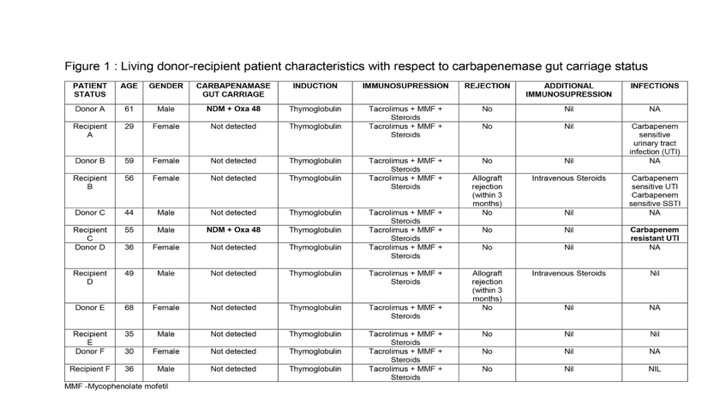
Significance of rectal carriage screening for carbapenem resistance in a living donor renal transplantation setting in India
Anusha Rohit1, Sneha Haridas Anupama2, Rajeevalochana Parthasarathy2, Sendhamarai Sairam1, Jagadeesan P1, Milly Mathew2, Georgi Abraham2.
1Microbiology, Madras Medical Mission , Chennai, India; 2Nephrology, Madras Medical Mission , Chennai, India
Background: Kidney transplant patients are at an increased risk of colonization and infections carbapenem-resistant organisms (CRO) due to their exposure to immunosuppressive medications, increased hospitalization and antibiotic exposures. The acquisition and impact of regular pre-transplant screening of donors and recipients for Cytomegalovirus and Epstein Barr virus infections are well known. We conducted a pilot study to understand carbapenemase gut carriage in donors and recipients pre-transplant and infections with CROs in recipients six months post-transplant.
Materials and Methods: This observational pilot study recruited six consecutive donor-recipient pairs for pre-transplant screening for gut carriage of carbapenemase by Gene Xpert Carba, Cepheid that detects KPC, NDM, VIM, IMP and OXA-48.
Data on previous infections, antibiotics received 30 days before transplant, induction agent, and immunosuppression used was collected. We observed all recipients for six months post-transplant to see if they developed infections caused by CROs. Each pair was classified as positive or negative for the donor and the recipient separately. We also noted any interim rejections, additional immunosuppressive agents used, and non-carbapenem resistant infections.
Results: Of the six pairs of donor-recipient pairs screened, one donor from one pair and one recipient from another pair was found to be a carrier (Figure 1).

Urinary tract Infection with a CRO was found only in the one recipient who was also the carrier. We observed allograft rejection in two patients who received IV steroids. These patients developed infections but not with CRO's.
Conclusions: This pilot study with all donor-recipient pairs is ongoing. However, immediately post-transplant, there appears to be no high risk of developing infections with a CRO when the donor is a carrier, and the recipient is not. Immunosuppression did not confer additional risk.
Though the sample size is small, one of the recipients who were a carbapenemase gut carrier developed an infection immediately post-transplant with a CRO.
This novel study in a living donor renal transplant setting will give a better understanding of the transmission dynamics of gut carriage of carbapenem-resistant bugs in renal transplant patients.
There are no comments yet...
